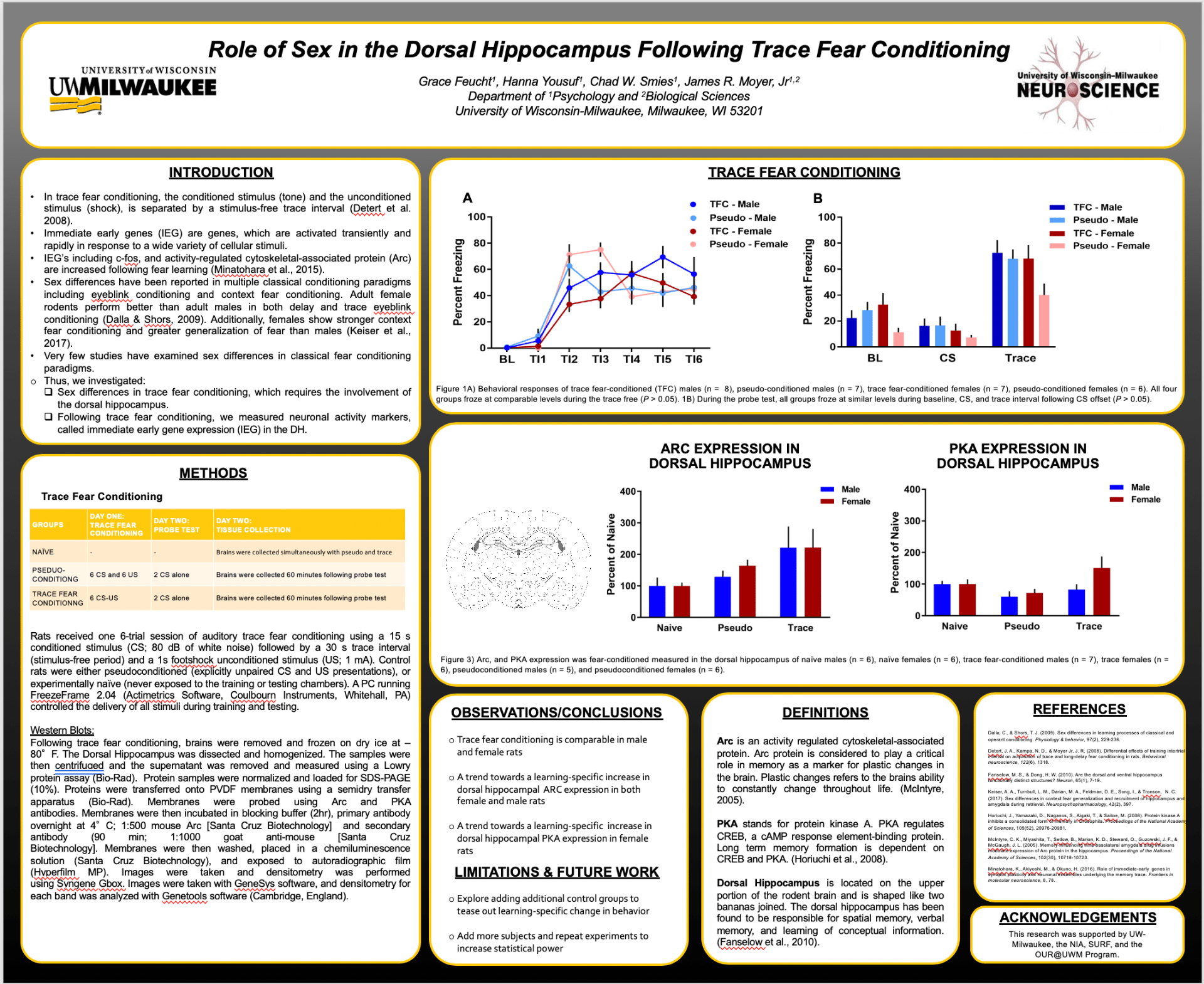Grace Feucht, “Sex Differences in Hippocampal Immediate-Early Gene Expression Following Context Fear Conditioning”
Mentor: James Moyer, Psychology
Women are twice as likely to suffer from posttraumatic stress disorder (PTSD) than males (Richards & Van Neil, 2017). PTSD can be modeled in the lab using Pavlovian fear conditioning. The paradigm used for this experiment is context fear conditioning, in which rodents learn to associate an environment with an aversive stimulus (foot shock). Some studies have shown sex differences in context fear learning (e.g., Maren et al., 1994). However, other work did not observe sex differences in short-term acquisition, instead observed sex differences in molecular mechanisms that may underlie differences in later retrieval of fear learning (Gresack et al., 2009). We used context fear conditioning in male and female rats to investigate how fear learning changes immediate early gene (IEG) expression. IEGs are activity markers that are evoked by environmental stimuli. We measured IEG expression in two brain regions that are important for context fear learning, the dorsal and ventral hippocampus. Context fear conditioning involves rats being placed in a conditioning chamber where they receive footshocks. Rats learn to associate the context with the footshocks, and this can be measured by freezing behavior. A day later, rats are placed in the same chamber but without footshocks and freezing behavior is measured. An hour later, their brains are removed and processed for protein analysis. Western blots are used to quantify the amount of IEG expression in the dorsal and ventral hippocampus. Initial behavioral results indicate that there are no sex differences in retrieval of context fear memories. Any observed sex differences in IEG expression in the hippocampi following memory retrieval, would suggest that the molecular mechanisms may differ between males and females even following comparable retrieval of context fear memories. Understanding sex differences in molecular mechanisms of fear learning may explain why females are more susceptible to PTSD.

Hello, Grace! Thank you for participating in undergraduate research! It can help you focus your career path. Your poster looks good visually, and I am unaware if they provided a standard poster blank to use. I hope not. I get what you did, and I was excited to see “nice actual use of ‘pre-sequencing era’ molecular tools in behavioral research.” You will improve with experience. I suggest the following
** The title in the program and the poster title differ. This makes searching potentially problematic and should be fixed. Choose one.
** Investigate the grammatical correctness of comma use. In the introduction, first two paragraphs, unnecessary commas distract the reader. To assess, read it aloud with an “extended” pause wherever you have a comma. Ask if it sounds right, or funny. If funny, get rid of it.
** Figures are clean looking and have error bars, but the independent variables are undefined. Some can be deduced from other text, but what are “BL” and “TI1, TI2, TI3”? Are these trial numbers (line graph) or time between stimuli (scatterplot)? The X-axes all need title labels.
** Results: There is no actual discussion of what the figures mean. Only one paired data set shows what appears to be a difference between males and females, but this is not addressed anywhere. Pseudo-conditioned females clearly showed desensitization, and you could make a point, with sound statistics, [note comma use to stress phrase] that special forces units in the military could produce “fearless” agents by using women soldiers conditioned in that manner.
** Abbreviations: define on first use (better), or in the “definition box” – DH was not though of course we could figure it out.
** Conclusions: “Comparable” gives no information. “Indistinguishable”, “the same”, etc. say something directional. Similar to issues you might see with “change” as opposed to “increase” or “decrease” etc.
Overall a good job visually and close with more attention to detail.
Overall, I think this was a great presentation. Having no background in Psychology, I was able to follow along and understand your presentation-It was accessible and easy to follow along. I appreciated the Definition box, too. I think the poster was well organized and had a great ratio of text, graphs, info, etc.
In your conclusion, you can be more specific. Saying “Trace fear conditioning is comparable…” is very broad, and I wasn’t sure what you were trying to convey. Other than that, I think it was very well put together!